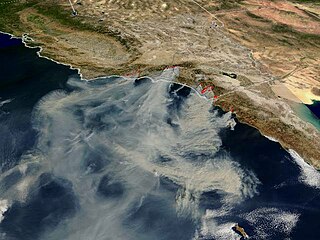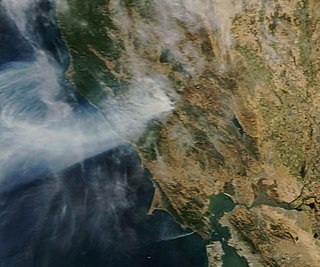
Paradise is a town in Butte County, California, United States in the Sierra Nevada foothills above the northeastern Sacramento Valley. As of the 2010 census, the town population was 26,218. On November 8, 2018, a major wildfire, the Camp Fire, destroyed most of Paradise and much of the adjacent communities of Magalia, Butte Creek Canyon, and Concow.

The Pacific Gas and Electric Company (PG&E) is an American investor-owned utility (IOU) with publicly traded stock. The company is headquartered in the Pacific Gas & Electric Building, in San Francisco, California. PG&E provides natural gas and electricity to 5.2 million households in the northern two-thirds of California, from Bakersfield and northern Santa Barbara County, almost to the Oregon and Nevada state lines.

The Cedar Fire was a massive, highly-destructive wildfire, which burned 273,246 acres (1,106 km2) of land in San Diego County, California, during October and November 2003. The fire's rapid growth was driven by the Santa Ana wind, causing the fire to spread at a rate of 3,600 acres (15 km2) per hour. By the time the fire was fully contained on November 4, it had destroyed 2,820 buildings and killed 15 people, including one firefighter. Hotspots continued to burn within the Cedar Fire's perimeter until December 5, 2003, when the fire was fully brought under control.
The Santiago Canyon Fire of 1889 was a massive wildfire in California, which burned large parts of Orange County, Riverside County, and San Diego County during the last week of September 1889. The fire reportedly started in Fremont Canyon, a canyon close to what today is Irvine Lake. Until 2018, it was possibly the single largest wildfire in the recorded history of California, with at least 300,000 acres (1,200 km2) of land burned. In mid-August 2018, the Ranch Fire in the Mendocino Complex Fire surpassed the Santiago Canyon Fire's assumed acreage.

The Witch Creek Fire, also known as the Witch Fire and the Witch-Guejito–Poomacha Complex Fire, was the second-largest wildfire of the 2007 California wildfire season, and the largest one of the October 2007 California wildfires. Although the Witch Creek Fire was individually smaller than the Zaca Fire of 2007, burning 197,990 acres (801 km2) acres alone, after merging with the Poomacha and McCoy Fires, the Witch–Guejito–Poomacha Complex Fire had a total burn area of 247,800 acres (1,003 km2), surpassing the Zaca Fire to become the largest complex fire of 2007. Initially igniting in Witch Creek Canyon, near Santa Ysabel, the Witch Creek Fire rapidly spread westward, fanned by powerful Santa Ana winds, and consumed large portions of San Diego County. On October 25, the Witch Fire merged with the Poomacha Fire to the north, near Palomar Mountain, before also merging with the smaller McCoy Fire on the next day. The Witch–Poomacha Complex Fire was the second-to-last fire of the 2007 October wildfires to be extinguished, with the Poomacha Fire being contained on November 13. The last remaining fire, the Harris Fire, was fully extinguished on November 16. During its duration, 80–100 feet-high flames were reported by fire officials in the Witch Fire, and the Witch Fire exhibited the characteristics of a firestorm at its height.

The October 2007 California wildfires, also known as the Fall 2007 California firestorm, were a series of about thirty wildfires that began igniting across Southern California on October 20. At least 1,500 homes were destroyed and approximately 972,147 acres of land was burned from Santa Barbara County to the U.S.–Mexico border, surpassing the October 2003 California wildfires in scope, which were estimated to have burned 800,000 acres (3,200 km2). The wildfires killed a total of 14 people, with nine of them dying directly from the fires; 160 others were injured, including at least 124 firefighters. At their height, the raging fires were visible from space. These fires included the vast majority of the largest and deadliest wildfires of the 2007 California wildfire season. The only wildfire in 2007 that surpassed any of the individual October 2007 fires in size was the Zaca Fire.

The Butte Fire was a rapidly moving wildfire during the 2015 California wildfire season that started on September 9 in Amador County, California. The fire burned 70,868 acres (287 km2).

In 2016, a total of 7,349 fires had burned an area 669,534 acres (2,709.51 km2) in California, according to the California Department of Forestry and Fire Protection.

In terms of property damage, 2017 was the most destructive wildfire season on record in California at the time, surpassed by only the 2018 season and the 2020 season, with a total of 9,560 fires burning 1,548,429 acres (6,266.27 km2) of land, according to the California Department of Forestry and Fire Protection, including five of the 20 most destructive wildland-urban interface fires in the state's history. Throughout 2017, the fires destroyed or damaged more than 10,000 structures in the state, a higher tally than the previous nine years combined. State data showed that the large wildfires killed 47 people – 45 civilians and 2 firefighters – almost higher than the previous 10 years combined. The total property damage and total amount of burned land were both surpassed by the 2018 California wildfires.

The October 2017 Northern California wildfires, also known as the Northern California firestorm, North Bay Fires, and the Wine Country Fires were a series of 250 wildfires that started burning across the state of California, United States, beginning in early October. Twenty-one became major fires that burned at least 245,000 acres (99,148 ha).

The 2018 wildfire season was the deadliest and most destructive wildfire season in California history. It was also the largest on record at the time, now second to the 2020 California wildfire season. In 2018, there were a total of 103 confirmed fatalities, 24,226 structures damaged or destroyed, and 8,527 fires burning 1,975,086 acres (799,289 ha), about 2% of the state's 100 million acres of land. Through the end of August 2018, Cal Fire alone spent $432 million on operations. The catastrophic Camp Fire alone killed at least 85 people, destroyed 18,804 buildings and caused $16.5 billion in property damage, while overall the fires resulted in at least $26.347 billion in property damage and firefighting costs, including $25.4 billion in property damage and $947 million in fire suppression costs.

The Camp Fire was the deadliest and most destructive wildfire in California's history, and the most expensive natural disaster in the world in 2018 in terms of insured losses.

The Woolsey Fire was a wildfire that burned in Los Angeles and Ventura Counties of the U.S. state of California. The fire ignited on November 8, 2018, and burned 96,949 acres of land. The fire destroyed 1,643 structures, killed three people, and prompted the evacuation of more than 295,000 people. It was one of several fires in California that ignited on the same day. While the nearby Hill Fire was contained with minimal damage on November 16, the Camp Fire in Northern California destroyed most of the town of Paradise, killing 85 people.

The 2019 wildfire season was a fire season in California, United States. As of December 22, 2019, over 7,860 fires have been recorded according to Cal Fire and the US Forest Service, totaling an estimated of 259,823 acres of burned land. Although the 2019 fire season had been relatively quiet in California through mid-September as compared to past years, October through December was still expected to have the greatest fire potential as the Diablo and Santa Ana winds pick up.

The Kincade Fire was a wildfire that burned in Sonoma County, California in the United States. The fire started northeast of Geyserville in The Geysers on 9:24 p.m. on October 23, 2019, and subsequently burned 77,758 acres (31,468 ha) until the fire was fully contained on November 6, 2019. The fire threatened over 90,000 structures and caused widespread evacuations throughout Sonoma County, including the communities of Geyserville, Healdsburg, Windsor, and Santa Rosa. The majority of Sonoma County and parts of Lake County were under evacuation warnings and orders. Lake county only had one evacuation order and that was the town of Middletown. The fire was the largest of the 2019 California wildfire season, and also the largest wildfire recorded in Sonoma County at the time before being surpassed by the LNU Lightning Complex fires in 2020.

The August 2020 California lightning wildfires were a series of 650 wildfires that ignited across Northern California in mid-August 2020, due to a siege of dry lightning from rare, massive summer thunderstorms, which were caused by an unusual combination of very hot, dry air at the surface, dry fuels, and advection of moisture from the remains of Tropical Storm Fausto northward into the Bay Area. These fires burned between 1,500,000 acres (6,100 km2) to 2,100,000 acres (8,500 km2) within a 2–3 week period. The August 2020 lightning fires included three enormous wildfires: the SCU Lightning Complex, the August Complex, and the LNU Lightning Complex. On September 10, 2020, the August Complex set a record for the single-largest wildfire in the modern history of California, reaching a total area burned of 471,185 acres (1,907 km2). On September 11, the August Complex merged with the Elkhorn Fire, another massive wildfire of 255,039 acres (1,032 km2), turning the August Complex into a monster wildfire of 746,607 acres (3,021 km2).

The El Dorado Fire, also colloquially known as the Gender Reveal Fire, was a wildfire burning during the 2020 California wildfire season and was burning in the area of Yucaipa, west of Oak Glen near Highway 38 in San Bernardino County, California in the United States. Igniting on Saturday, September 5, near the winding two-lane Oak Glen Road, expanded to 22,744 acres (9,204 ha) and destroyed 10 structures, including 4 residences, and damaged 6 others. The fire was caused by a pyrotechnic device at a gender reveal party and spread rapidly, causing one fatality.
The Gaviota Coast in Santa Barbara County, California is a rural coastline along the Santa Barbara Channel roughly bounded by the city of Goleta and the north boundary of the county. This last undeveloped stretch of Southern California coastline consists of dramatic bluffs, isolated beaches and terraced grasslands.

The Dixie Fire was an enormous wildfire in Butte, Plumas, Lassen, Shasta, and Tehama Counties, California. It is named after the creek near where it started. The fire began in the Feather River Canyon near Cresta Dam on July 13, 2021, and burned 963,309 acres (389,837 ha) before being 100% contained on October 25, 2021. It was the largest single wildfire in recorded California history, and the second-largest wildfire overall. The fire damaged or destroyed several small towns, including Greenville on August 4, Canyondam on August 5, and Warner Valley on August 12.
















